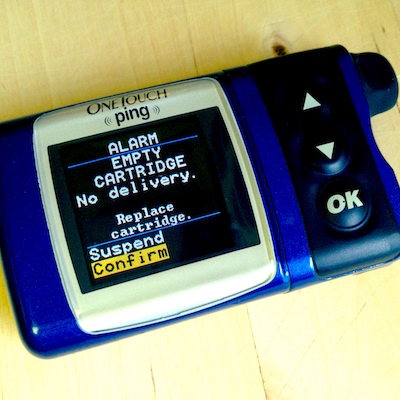In which I reflect on my choice to switch from a Medtronic to an Animas insulin pump and the one tiny design difference between the two pumps that has caused me a surprising amount of grief.
Insulin Pumps, Choice, and Design
I’ve been using an Animas/OneTouch Ping insulin pump for nearly the past two years. Before that, I used a Medtronic Paradigm 522 pump for about four years.
Medtronic and Animas are the two biggest names in insulin pumps. At least in the U.S., these two companies are dominant, with Roche’s Accu-Chek insulin pumps and the tubeless Omnipod system occupying smaller shares of the market1. (There are some very recent new-comers, such as the Tandem t:slim and Cellnovo systems, but these are so new and restricted in availability that they aren’t major players as of yet.)
Choosing between a Medtronic and an Animas insulin pump is largely a matter of deciding which design factors are most important to you. The technical specs with respect to the precision of insulin delivery that each pump offers and the options for delivering different types of boluses and setting basal rate programs are largely indistinguishable (in my opinion), so the decision comes down to other factors, such as whether or not the pump is waterproof or just water-resistant.
For me, the choice to switch to the Animas/OneTouch Ping pump was entirely motivated by one design feature: the ability to program a bolus remotely from the OneTouch Ping blood glucose meter that comes with the pump. I’ve been quite happy with the pump in this respect. I like to wear my insulin pump concealed, tucked into a sheath that I wear around my calf, so the ability to remotely take a bolus of insulin makes it so that I don’t have to constantly roll up my pant leg and fish out my pump (which is, truthfully, what I did before with my Medtronic pump).
Features and Bugs: Or, the Importance of Dishonesty in an Insulin Pump
What’s been a real surprise to me with the Animas pump is one tiny design decision that’s different between the two pumps: namely, the Medtronic pump lies, but the Animas pump is cruelly honest.
What do I mean? The issue is this: when the Medtronic pump says that the insulin reservoir is empty, it’s actually lying to you: there’s a good 10-15 units of insulin left. That’s enough for me to get through about 12 hours, typically, so since I started on the Medtronic pump I got used to not worrying about changing my infusion site until the reservoir registered at zero.

The Animas pump, on the other hand, always tells the truth. Zero means zero. Or, rather, zero means no insulin delivery. And this is something I can’t seem to get used to. I’ve had the low reservoir alert on both pumps set to go off when there are only 20 units of insulin left in the reservoir, but still this “empty cartridge, no delivery” alarm is a regular occurrence for me.
Despite the fact that I’ve been using this pump for nearly two years, I can’t seem to get used to the fact that empty means empty. All this is just to say that even the tiniest details can make a huge difference in how well a design works for a certain patient.
-
Note to self and readers—citation needed! ↩